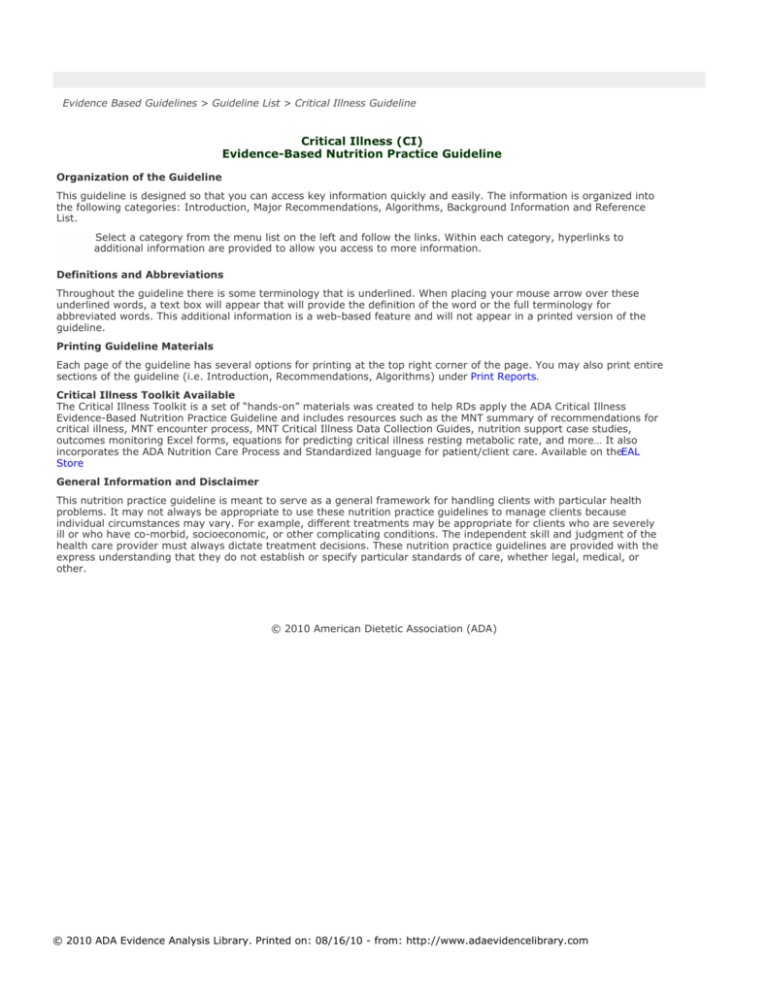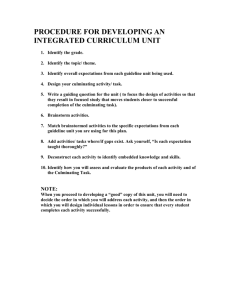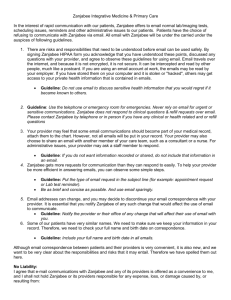Critical Illness (CI) Evidence-Based Nutrition Practice Guideline
advertisement

Evidence Based Guidelines > Guideline List > Critical Illness Guideline Critical Illness (CI) Evidence-Based Nutrition Practice Guideline Organization of the Guideline This guideline is designed so that you can access key information quickly and easily. The information is organized into the following categories: Introduction, Major Recommendations, Algorithms, Background Information and Reference List. Select a category from the menu list on the left and follow the links. Within each category, hyperlinks to additional information are provided to allow you access to more information. Definitions and Abbreviations Throughout the guideline there is some terminology that is underlined. When placing your mouse arrow over these underlined words, a text box will appear that will provide the definition of the word or the full terminology for abbreviated words. This additional information is a web-based feature and will not appear in a printed version of the guideline. Printing Guideline Materials Each page of the guideline has several options for printing at the top right corner of the page. You may also print entire sections of the guideline (i.e. Introduction, Recommendations, Algorithms) under Print Reports. Critical Illness Toolkit Available The Critical Illness Toolkit is a set of “hands-on” materials was created to help RDs apply the ADA Critical Illness Evidence-Based Nutrition Practice Guideline and includes resources such as the MNT summary of recommendations for critical illness, MNT encounter process, MNT Critical Illness Data Collection Guides, nutrition support case studies, outcomes monitoring Excel forms, equations for predicting critical illness resting metabolic rate, and more… It also incorporates the ADA Nutrition Care Process and Standardized language for patient/client care. Available on the EAL Store General Information and Disclaimer This nutrition practice guideline is meant to serve as a general framework for handling clients with particular health problems. It may not always be appropriate to use these nutrition practice guidelines to manage clients because individual circumstances may vary. For example, different treatments may be appropriate for clients who are severely ill or who have co-morbid, socioeconomic, or other complicating conditions. The independent skill and judgment of the health care provider must always dictate treatment decisions. These nutrition practice guidelines are provided with the express understanding that they do not establish or specify particular standards of care, whether legal, medical, or other. © 2010 American Dietetic Association (ADA) © 2010 ADA Evidence Analysis Library. Printed on: 08/16/10 - from: http://www.adaevidencelibrary.com Evidence Based Guidelines > Guideline List > Critical Illness Guideline > Introduction Guideline Overview Guideline Title Critical Illness Evidence-Based Nutrition Practice Guideline Guideline Narrative Overview The focus of this guideline is on the nutrition care of the critically ill patient who requires nutrition support. The goals of nutrition support in well-nourished and malnourished critically ill patients are to promote acute phase and whole body protein synthesis and to prevent physiologic deterioration. Clinical judgment is crucial in the application of this guideline. Guideline Development This guideline outlines the most current information on nutrition support practice in the critically ill patient. The recommendations developed in this guideline were based upon a systematic review of the literature in multiple practice areas. A summary of the evidence analysis is below: Topics include: Enteral vs. Parenteral Nutrition Timing of Feeding Immune-Enhancing Enteral Nutrition Feeding Tube Site Blue Dye Use Monitoring Criteria in Critical Illness Monitoring Delivery of Energy Blood Glucose Control - 09/29/09 Recommendation removed and currently under revision. Energy Expenditure Energy Assessment. The recommendations involving energy expenditure are based, in part, on the work performed by the ADA indirect calorimetry evidence analysis working group, evaluating questions related to measurement of resting metabolic rate via indirect calorimetry3. The number of supporting documents for these topics is below: Recommendations: 27 Conclusion Statements: 57 Evidence Summaries: 31 Article Worksheets: 112. To view the guideline development and review process, click here. Application of the Guideline This guideline will be accompanied by a set of companion documents (i.e., a toolkit) to assist the practitioner in applying the guideline. The toolkit will contain materials such as the Medical Nutrition Therapy protocol, documentation forms, outcomes management tools, resources and case studies. The toolkit is currently under development and will undergo pilot-testing through the ADA's Dietetic Practice-Based Research Network prior to publication. Revision A repeated literature search will be done for each on a yearly basis to see if any new research has been published since the previous search was completed. The results of the search will be recorded, dated and labeled as reviewed. When new research is identified, a determination will be made about whether it could change the published recommendation or rating. If the determination is that there is no change, then the search is recorded and saved until the next annual review and no further action is taken. If the determination is that there could be a change in either the recommendation or the rating, then the question(s) will be re-analyzed following the standard ADA Evidence Analysis Process (see ADA Evidence Analysis Manual). When the analysis is completed, the expert workgroup will review and re-grade the conclusions and recommendations. Populations to Whom This Guideline May Apply Medical and surgical conditions where the critical illness guideline may apply include those in which the patient requires care in an intensive care unit, such as: Sepsis and systemic inflammatory response syndrome (SIRS) Trauma © 2010 ADA Evidence Analysis Library. Printed on: 08/16/10 - from: http://www.adaevidencelibrary.com Head injury Pancreatitis Respiratory failure Neurological injury Multi-organ failure. Study Limitations Some ICU studies are limited by small sample size or the lack of statistical power analyses. These limitations may be reflected in statements made in reviewing evidence summaries, conclusions and associated grades of evidence. Performing power analysis and sample size estimation is an important aspect of designing an experiment, because without these calculations, the number of subjects recruited for a specific research question may be too few or too many. If sample size is too small, the study will lack the precision to provide reliable answers to the questions it is investigating. If the sample size is too large, the study may be difficult to perform and be costly. Power is broadly defined as the probability that a test having statistical significance will reject the null hypothesis for a specified value of an alternative hypothesis. Stated more simply, power may be defined as the ability of a test to detect an effect, given that the effect actually exists. Other Guideline Overview Material For more details on the guideline components, click an item below: Scope of Guideline Statement of Intent and Patient Preference Guideline Methods Implementation of the Guideline Benefits and Harms of Implementing the Recommendations. Contraindications This guideline should not be used in those for whom aggressive medical care is no longer desired. The appropriateness of a clinical intervention involves a substantial element of personal choice or values of the patient, which includes advance directives. Although nutrition support is often warranted for the critically ill patient, occasionally, support may be contraindicated due to the patient's clinical status or patient preference. Therefore, a comprehensive nutrition assessment and ongoing reassessment is necessary to determine whether the initiation or continued provision of support is appropriate. References 1. Vrees MD, Albina JE. Metabolic response to illness and its mediators. Clinical Nutrition: Parenteral Nutrition, Rombeau JL, Rolandelli RH (eds). WB Saunders, Philadelphia, 2000, pp. 21, 034. 2. ASPEN Board of Directors: Guidelines for the use of parenteral and enteral nutrition in adult and pediatric patients. J Parenter Enteral Nutr. 26 (suppl) 1S, 2002. 3. Compher C. Frankenfield D. Keim N, Roth-Yousey L. for the Evidence Analysis Working Group. Best practice methods to apply to measurement of resting metabolic rate in adults: a systematic review. J Am Diet Assoc. 2006; 106: 881-903. Go to Scope of Guideline © 2010 American Dietetic Association (ADA) © 2010 ADA Evidence Analysis Library. Printed on: 08/16/10 - from: http://www.adaevidencelibrary.com Evidence Based Guidelines > Guideline List > Critical Illness Guideline > Introduction > Scope of Guideline Guideline Scope Characteristics Below you will find a list of characteristics that describe the Scope of this Guideline. Disease/Condition(s) The purpose of this guideline is to provide an evidence-based summary of effective practice in the nutrition management for the critically ill. Recommendations have been formulated to promote positive clinical outcomes specific to clinical practice decisions pertinent to nutrition of the critically ill. The major focus of this guideline is to provide protocols for the delivery and monitoring of enteral nutrition (EN). The guideline is intended to be used by dietetic practitioners involved in the nutritional care of the critically ill. These guidelines may also serve as a valuable resource for dietetic practitioners providing medical nutrition therapy (MNT) for patients in other non-critical care healthcare settings or alternative healthcare settings requiring EN. These guidelines are intended to provide healthcare practitioners with direction based on the current science for nutrition of the critically ill in order to promote positive clinical outcomes. Guideline Category Assessment of Therapeutic Effectiveness, Treatment Clinical Specialty Critical Care, Nutrition Intended Users Registered Dietitians, Advanced Practice Nurses, Health Care Providers, Nurses, Pharmacists, Physician Assistants, Physicians, Respiratory Care Practitioners, Speech-Language Pathologists, Students Guideline Objective(s) Overall Objective To provide MNT guidelines for nutrition of the critically ill to enhance delivery and reduce complications. Specific Objectives To define evidence-based recommendations for the provision of EN by registered dietitians (RDs) in collaboration with other healthcare providers To guide practice decisions that integrate medical and nutritional elements To reduce variations in practice among RDs To provide the RD with data to make recommendations to adjust the MNT or recommend other therapies to achieve outcomes To enhance the quality of life for the patient, utilizing customized strategies based on the individual's nutritional needs To define the highest quality of care within cost constraints of the current healthcare environment. Target Population Adult (19 to 44 years), Middle Age (45 to 64 years), Aged (65 to 79 years), Male, Female Target Population Description Adult critically-ill patients requiring or eligible for EN support in the intensive care unit (ICU). The evidence for the guideline did not specifically examine populations that were exclusively patients with burns. These guidelines are not applicable to pediatric populations. © 2010 ADA Evidence Analysis Library. Printed on: 08/16/10 - from: http://www.adaevidencelibrary.com Interventions and Practices Considered I. Referral to a Registered Dietitian II. Medical Nutrition Therapy A. Nutrition Assessment Below you will find the nutrition assessment terms related to critical illness care from International Dietetics & Nutrition Term International Dietetics & Nutrition Terminology Reference Manual: Standardized Language for the Nutrition Care Process, Second Edition. To view a complete list of all nutrition assessment terms, click here. 1. Medical history to include assessment of gastrointestinal function and relevant laboratory values for nutritional status. 2. Nutrition-focused assessment including: Height, weight, BMI Nutrition history Lifestyle habits, including physical activity and tobacco or substance abuse Medical issues impacting nutrition therapy; to include medical or surgical history Considerations of comorbid conditions and need for additional modifications in nutrition care plan. B. Nutrition Diagnosis Below you will find the nutrition diagnoses related to critical illness care from International Dietetics & Nutrition Termi International Dietetics & Nutrition Terminology Reference Manual: Standardized Language for the Nutrition Care Process, Second Edition. To view a complete list of all nutrition diagnoses, click here. Hypermetabolism (NI-1.1) Hypometabolism (NI 1.3) Inadequate energy intake (NI-1.4) Excessive intake (NI-1.5) Inadequate oral food or beverage intake (NI-2.2) Inadequate intake from EN or parenteral nutrition (PN) infusion (NI-2.3) Excessive intake from EN or PN infusion (NI-2.4) Inappropirate infusion of EN or PN infusion (NI-2.5). C. Comprehensive Intervention (Planning and Implementation) Below you will find the nutrition interventions related to critical illness care from International Dietetics & Nutrition Terminology Reference Manual: Standardized Language for the Nutrition Care Process, Second Edition. To view a complete list of all nutrition interventions, click here. Individualized prescription based on: 1. Nutritional needs of patient 2. Medical status 3. Current clinical status. D. Monitoring and Evaluation Below you will find the nutrition monitoring and evaluation terms related to critical illness care from International Dietetics & Nutrition Terminology Reference Manual: Standardized Language for the Nutrition Care Process, Second Edition. To view a complete list of all nutrition monitoring and evaluation terms, click here. 1. Individualized prescription based on monitoring criteria for tolerance of EN. Go to Statement of Intent © 2010 ADA Evidence Analysis Library. Printed on: 08/16/10 - from: http://www.adaevidencelibrary.com © 2010 American Dietetic Association (ADA) © 2010 ADA Evidence Analysis Library. Printed on: 08/16/10 - from: http://www.adaevidencelibrary.com Evidence Based Guidelines > Guideline List > Critical Illness Guideline > Introduction > Statement of Intent Statement of Intent Evidence-based nutrition practice guidelines are developed to help dietetic practitioners, patients and consumers make shared decisions about health care choices in specific clinical circumstances. If properly developed, communicated and implemented, guidelines can improve care. While they represent a statement of best practice based on the latest available evidence at the time of publishing, they are not intended to overrule professional judgment. Rather, they may be viewed as a relative constraint on individual clinician discretion in a particular clinical circumstance. The independent skill and judgment of the health care provider must always dictate treatment decisions. These nutrition practice guidelines are provided with the express understanding that they do not establish or specify particular standards of care, whether legal, medical or other. The Role of Patient Preference This guideline recognizes the role of patient preferences for possible outcomes of care, when the appropriateness of a clinical intervention involves a substantial element of personal choice or values. With regard to types of evidence that are associated with particular outcomes, Shaughnessy and Slawson (1-3) describe two major classes. Patient-oriented evidence that matters (POEM) deals with outcomes of importance to patients, such as changes in morbidity, mortality or quality of life. Disease-oriented evidence (DOE) deals with surrogate end-points, such as changes in laboratory values or other measures of response. Although the results of DOE sometimes parallel the results of POEM, they do not always correspond. When possible, ADA recommends using POEM-type evidence rather than DOE. When DOE is the only guidance available, the guideline indicates that key clinical recommendations lack the support of outcomes evidence. References 1. Slawson DC, Shaughnessy AF. Becoming an information master: using POEMs to change practice with confidence. Patient-Oriented Evidence that Matters. J Fam Pract. 2000 Jan;49(1):63-7. Erratum in: J Fam Pract 2000 Mar;49(3):276. 2. Slawson DC, Shaughnessy AF, Ebell MH, Barry HC. Mastering medical information and the role of POEMs--Patient-Oriented Evidence that Matters. J Fam Pract. 1997 Sep;45(3):195-6. 3. Shaughnessy AF, Slawson DC. POEMs: patient-oriented evidence that matters. Ann Intern Med. 1997 Apr 15;126(8):667. Go to Guideline Methods © 2010 American Dietetic Association (ADA) © 2010 ADA Evidence Analysis Library. Printed on: 08/16/10 - from: http://www.adaevidencelibrary.com Evidence Based Guidelines > Guideline List > Critical Illness Guideline > Introduction > Guideline Methods General and Specific Methods for Critical Illness Guideline Below are links to both the general methods that ADA has put in place for evidence analysis and creating the guidelines, as well as the specific search methods and criteria for each question. General Methods Click here to view a description of the ADA's process of evidence analysis and guideline creation. Methods for Specific Topics Click here to view descriptions of search criteria and findings for each topic covered in this guideline. History of the Development of This Guideline This guideline is the first edition of the ADA Critical Illness Evidence-Based Nutrition Practice Guideline. Go to Implementation of Guideline © 2010 American Dietetic Association (ADA) © 2010 ADA Evidence Analysis Library. Printed on: 08/16/10 - from: http://www.adaevidencelibrary.com Evidence Based Guidelines > Guideline List > Critical Illness Guideline > Introduction > Implementation of the Guideline Implementation of the Guideline The publication of this guideline is an integral part of the plans for getting the ADA evidence-based recommendations on critical illness to all dietetics practitioners engaged in, teaching about or researching critical illness as quickly as possible. National implementation workshops at various sites around the country and during the ADA Food Nutrition Conference Expo (FNCE) are planned. Additionally, there are recommended dissemination and adoption strategies for local use of the ADA Critical Illness Evidence-Based Nutrition Practice Guideline. The guideline development team recommended multi-faceted strategies to disseminate the guideline and encourage its implementation. Management support and learning through social influence are likely to be effective in implementing guidelines in dietetic practice. However, additional interventions may be needed to achieve real change in practice routines. Implementation of the critical illness guideline will be achieved by announcement at professional events, presentations and training. Some strategies include: National and local events: State dietetic association meetings and media coverage will help launch the guideline Local feedback adaptation: Presentation by members of the work group at peer review meetings and opportunities for CEUs for courses completed Education initiatives: The guideline and supplementary resources will be freely available for use in the education and training of dietetic interns and students in approved Commission on Accreditation of Dietetics Education (CADE) programs Champions: Local champions will be identified and expert members of the guideline team will prepare articles for publications. Resources will be provided that include PowerPoint presentations, full guidelines and pre-prepared case studies. Practical tools: Some of the tools that will be developed to help implement the guideline include specially designed resources such as clinical algorithms, a pocket guide, slide presentation, training and toolkits. Specific distribution strategies include: Publication in full: The guideline will be available electronically at the ADA Evidence Analysis Library website (www.adaevidencelibrary.com) and will be announced to all the dietetic practice groups. The ADA Evidence Analysis Library will also provide downloadable supporting information. Go to Benefit and Risks © 2010 American Dietetic Association (ADA) © 2010 ADA Evidence Analysis Library. Printed on: 08/16/10 - from: http://www.adaevidencelibrary.com Evidence Based Guidelines > Guideline List > Critical Illness Guideline > Introduction > Benefits and Risks/Harms of Implementing Benefits and Risks/Harms of Implementing the Recommendations Safety issues should be considered for each form of treatment recommended. A description of the general benefits and risk associated with the implementation of this guideline must be addressed. To view more information, select the link to the topic listed after each potential benefit/harm. Potential Benefits A priority aim and benefit of implementing this guideline would be to improve the percentage of individuals who are appropriately nourished while in the intensive care unit (ICU), thus leaving the ICU earlier, with fewer infectious complications and no aspiration pneumonia (Enteral vs. Parenteral Nutrition) Enteral nutrition (EN) begun within 24 to 48 hours of injury or admission to the ICU is associated with fewer infectious complications and a shorter length of ICU stay (Timing of Enteral Nutrition) Feeding tubes placed in the small bowel are associated with reduced gastric residual volumes (GRV) and less reflux and may be particularly useful for patients who require supine positioning or have had large GRV (Gastric vs. Small Bowel Feeding Tube Placement) Use of promotility agents is associated with lower GRV (Monitoring Criteria in Critical Illness: Promotility Agents) Positioning the head of the patient's bed at 45 degrees reduces the incidence of aspiration pneumonia and reflux of gastric contents ( Monitoring Criteria in Critical Illness: Patient Positioning) Intake of EN is greater if an isolated GRV of 250ml is accepted and if two GRV of 250ml are allowed before EN is stopped or held (Monitoring Criteria in Critical Illness: Gastric Residual Volume) Strict glycemic control (80mg/dL to 110mg/dL) is associated with reduced time on the ventilator for medical ICU ICU patients. Blood glucose control below 140mg/dL is associated with fewer infectious complications (Glucose Control: Blood Glucose Control) Providing ICU patients with 14kcal/kg to 18 kcal/kg or 60% to 70% of energy goals is associated with a reduced LOS, less time on the ventilator and fewer infections (Monitoring Delivery of Energy) Compared with parenteral nutrition, EN results in fewer infectious complications and a lower cost of medical care (Enteral vs. Parenteral Nutrition) Measured RMR, when used as a feeding strategy, provides information to minimize the chances of overfeeding if applied to caloric delivery (Determination of Resting Metabolic Rate). Risk/Harm Considerations Factors to consider when exploring treatment options include: The use of immune-enhancing EN in severely ill patients may be associated with increased mortality (Immune-Enhancing Enteral Nutrition) Patients admitted to the ICU should be fluid-resuscitated before early EN is attempted (Timing of Enteral Nutrition ) Blue dye, in excessive doses or used in patients with increased gut permeability, may increase mortality and the risks of the use of blue dye in EN outweigh the benefits. Use of blue dye in EN should be abandoned (Blue Dye Use) Feeding patients in a medical ICU or surgical patients with obesity, more than 70% of estimated goal for nutrition support may be associated with less positive outcomes (Monitoring Delivery of Energy) Serum glucose levels over 140mg/dL are associated with increased mortality in critically ill patients (Glucose Control: Blood Glucose Control). Factors to consider when exploring the use of indirect calorimetry to measure RMR are below (1) (Determination of Resting Metabolic Rate) Some patients may experience anxiety or claustrophobia with some gas collection devices, resulting in artificially high RMR measures. In this case, a different device should be used or the patient should not be measured. Patients with severe malnutrition risk inadequate nutritional repletion by long fasts. Patients with IDDM risk hypoglycemia with longer fasts. The time needed for rest extends the time invested in obtaining the measures. References 1. American Association for Respiratory Care (AARC). Metabolic measurement using indirect calorimetry during © 2010 ADA Evidence Analysis Library. Printed on: 08/16/10 - from: http://www.adaevidencelibrary.com 1. American Association for Respiratory Care (AARC). Metabolic measurement using indirect calorimetry during mechanical ventilation. Clinical practice guidelines. Respir Care. 1994; 39 (12): 1, 170-1, 175. Return to Guideline Home Page © 2010 American Dietetic Association (ADA) © 2010 ADA Evidence Analysis Library. Printed on: 08/16/10 - from: http://www.adaevidencelibrary.com © 2010 ADA Evidence Analysis Library. Printed on: 08/16/10 - from: http://www.adaevidencelibrary.com






